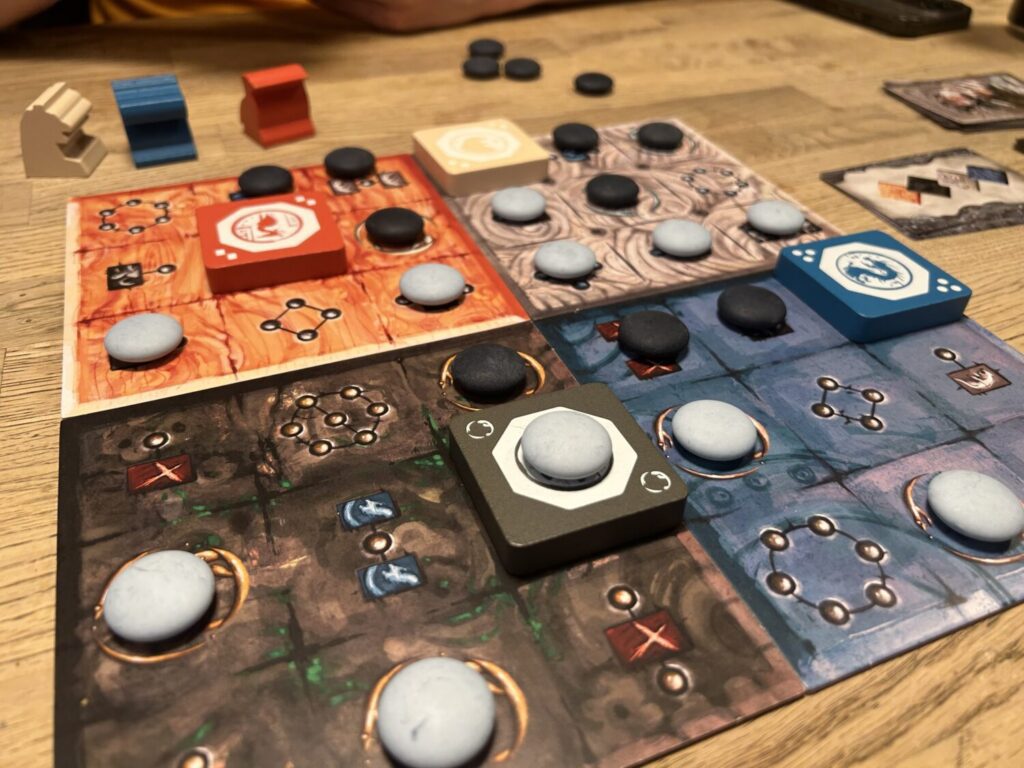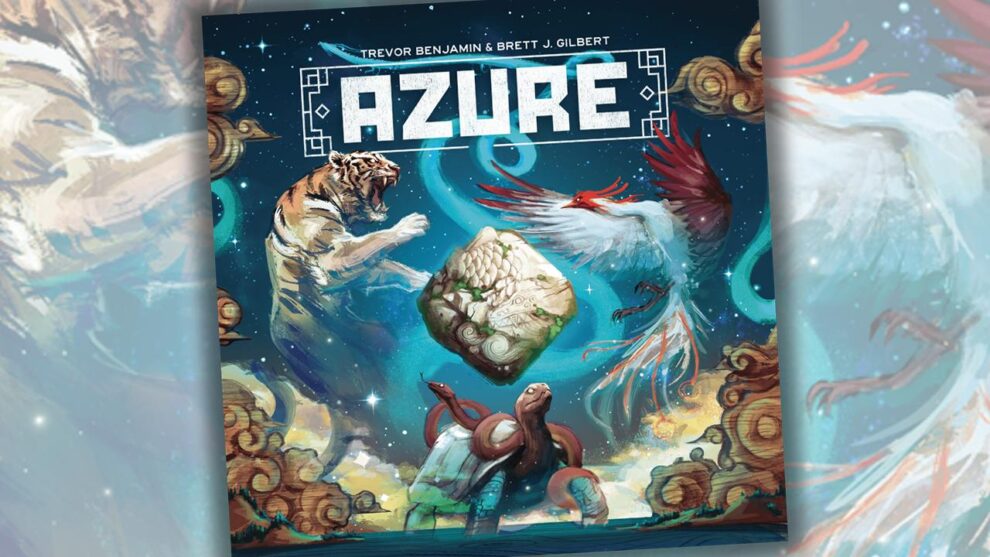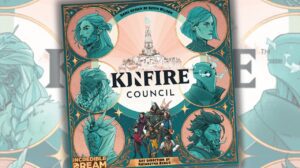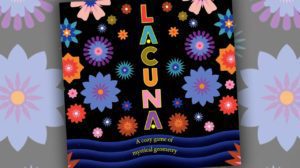Disclosure: Meeple Mountain received a free copy of this product in exchange for an honest, unbiased review. This review is not intended to be an endorsement.
It happened again. I’m in love. There’s nothing to be done. I thought I was too old for such shenanigans, too over the idea of romànce to lose myself so fully. I lose focus during work meetings, daydreaming away, thinking about the next time I get to see the subject of my adoration. I look down at my desk and see no work. Rather, my legal pad is covered with page after page of the same name, unending, in a cavalcade of fonts and scripts.
“Azure,” I write, over and over again. Azure, Azure, Azure.
Dream Team
You don’t have to work hard to get me to look at a new two-player game from designers Trevor Benjamin & Brett J. Gilbert. In the last six or seven years, they’ve released two of my favorite two-handers, Mandala and Patterns, as well as the overlooked Great Plains. Their best games offer a rare and exquisite combination of simple rules, intense player interaction, and decision spaces that reward skilled play. They also have a knack for creating games that are “squishy,” a word I use for decision spaces that never quite yield to the clinical mind. Playing their games, you end up saying, “I think this is the best move?” an awful lot.
Any new game from Benjamin and Gilbert is cause for celebration, but I was especially pleased to see that their next title, Azure, had found a home with Bitewing Games. Those Utah-based Kniziaphiles marry top-flight production value to games that harken back to a slightly older school of design. While most of their games to date have struggled to leave an impression stronger than “enjoyable,” I have always been excited to see what they cook up next. They use ingredients I love. We were bound to end up with a favorite dish one of these days.
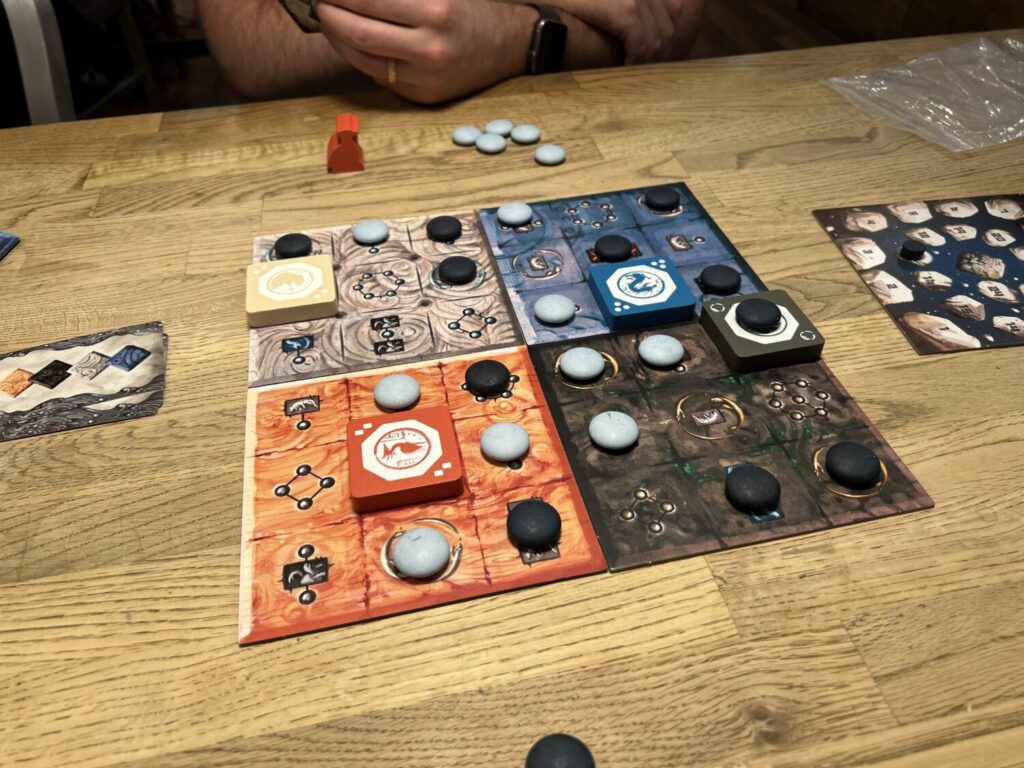
Dinner Is Served
Azure is a two-player abstract game, a race to 25 points. On your turn, you pay cards to place one of your stones onto a space on the board. The number of cards you have to pay is determined by the number of icons in the space, and the suit with which you have to pay is determined by the color of the space. Decisions around where to place stones on your turn are influenced by a number of things.
First, there’s the immediate benefit of the space itself. Some give you points, some let you take cards into your hand, and some do a combination of the two. Then there’s the long-term benefit of the position. Stones that you place on the board give you a discount on other spaces in the same row and column. A white space worth four points normally costs four white cards. If I have two stones that can “see” that space, that share either its row or column, I only have to pay two cards. The highest scoring spaces on the board are worth six or seven points each, quantities you are unlikely to be able to pay through cards alone, so thinking about your long term scoring prospects is important.
Third, your stones help you earn the bonuses afforded by the four powerful Auspicious Beasts. Each Beast has a unique bonus: the Azure Dragon and White Tiger each afford their chosen player points, the Vermillion Bird allows you to draw two cards at random from a small prepared deck, and the Black Tortoise gives you an extra stone. Each Beast is won over in a different way, related to stone positions on the board, and you cannot take their favor for granted. If your opponent plays more stones to the appropriate locations than you, they can take the Beast away from you. Not only do they gain whatever benefit it affords, you lose it.
Gunning for these Beasts is a big part of the early game, though you shouldn’t do so with abandon. The four sections of the board are modular, laid out randomly during setup, and the placement of each of those Auspicious Beasts and their corresponding Mountains plays an important part in deciding which ones to pursue. Different layouts encourage different approaches. If the Tortoise isn’t lined up with anything worth discounting, it may be a waste of a stone. In fact, you lose the game if you can’t place a stone on your turn, and I lost an early game because securing the Tortoise without much benefit meant I was down a stone when we got to the final round.
The resulting game has proven to be tense, quick, and rude. The more you play Azure, the ruder it gets. Outside of your initial hand of cards, and the cards afforded by the Vermillion Bird, Azure is a perfect information game, albeit one that requires card counting. You don’t gain cards without your opponent seeing them, which means, by and large, that you cannot take spaces your opponent doesn’t know you can take. Cards are gained slowly, so more expensive spaces are won by thinking about the war instead of the battle. People block, they stymie, they get up to general shenanigans.
At the end of my first game, for the first time in ages, I found myself compelled to immediately play a game again. So did my opponent. In fact, every person I’ve introduced to Azure has wanted to play a second time. The simplicity of the system and the interactivity of the play experience make it something you want to get better at, to understand, to, dare I say it, master.
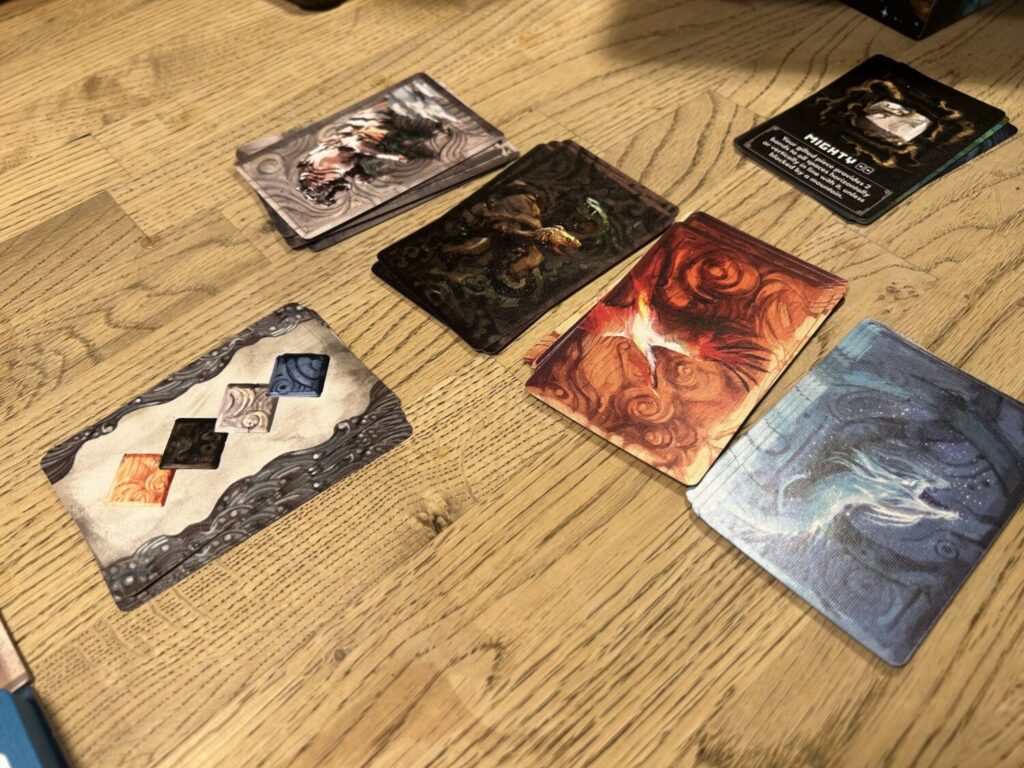
When You’re a Fool in Love
Look. I’m not a fool. I know how it goes. Adoration, love, a crush, it can hit hard and fade fast. I recognize as much as anyone that there’s no way to know how Azure will hold up to repetition. I even have concerns to that effect. While the board creates a good amount of not only superficial but substantive variety, individual sessions don’t feel meaningfully distinct from one another. The game has a fairly consistent pace and rhythm. You build up your board position and your card supply before pivoting to snap up points as the end of the game approaches. I happen to love the pace and rhythm of Azure, so I don’t know that that will ever be an issue for me.
Before my most recent game, I would have also expressed concerns about the strategic limitations. “There are requirements,” I was planning on writing. “Don’t pay for a two-card position at the start of the game; it costs too much. Don’t let your opponent get more than two Auspicious Beasts, and be sure to prioritize the one that gives you cards early in the game.” In a game this short, those sorts of limitations would be big asterisks. But the last game I played before writing this review broke both those rules. I managed to win in a massive and come-from-behind rush despite never managing to even threaten either of the Beasts that grant points, losing the Tortoise halfway through the match, and taking the Bird from my opponent close to the end of the game. There’s more flexibility here than you might initially suspect.
Rather than expose the constraints of this admirably small design, each subsequent play has revealed greater pleasures. I find myself more easily keeping track of what cards my opponent has picked up, more capable of reading the most important spaces on the board to claim early, more aware of which Auspicious Beasts are and aren’t worth bothering with this time around. If anything, the most salient concern seems to be the opposite: given how reliant skilled play is on tracking your opponent’s supply of cards and diagnosing the board during setup, experienced players may find it difficult to introduce new players, since new players will find themselves being used to mop up.
That’s not a bad thing, though. It’s simply something to be aware of. The list of games in which experienced players can and will reliably trounce new players is also largely a list of my favorite and most-admired designs. It is indicative of a game that rewards thought, consideration, and familiarity. I’m the first to acknowledge that I am besotted with Azure, but I have yet to see a shred of evidence that I shouldn’t be.
